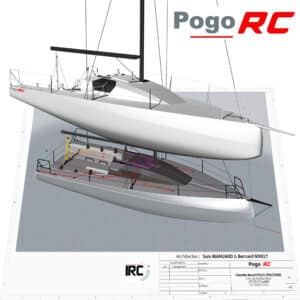
X35GU368
As we rigged up Richard Casner’s X-35 One-Design for the Sail For Hope on Saturday, I did a quick double take. “What,” I thought to myself, “are all these lines for?” It has been quite a few months since I’d raced a boat larger than 24-feet with a symmetric spinnaker and it took me a second to adjust to all the lines we needed to run. It wasn’t just the sheets and guys, but also the twings for each sheet, and the shock-corded rings that keep the lazy guy under control. There was also the twin controls for the foreguy, not to mention the topping lift and jib and spinnaker halyards.But after I recalibrated my expectations, I quickly settled into a very pleasurable lap of Conanicut Island. I was excited about the race for two reasons. Firstly, the Sail For Hope has always been a great way to wave goodbye to the summer sailing season. More often than not, the weather has been fabulous. This Sunday didn’t disappoint. But I was equally as interested to sail on the X-35. While it hasn’t gotten much traction in the United States, the X-35 is hugely popular in Europe. The class’s 2007 world championship, its second, pulled in 35 entries.It didn’t take me long to discover why the boat has struck such a chord across the pond. The 35 is an easy boat to race and one that also rewards skill, experience, and effort. The cockpit is plenty big enough for the four people needed to tack the boat upwind, and with the Cunningham, vang, outhaul and foreguy lead to both sides of the cockpit, the sail controls most essential for switching gears are within easy reach of the crew. The mainsheet is led grand-prix style to a pair of winches. This is near the bottom of the size range for this set-up, but it works well on the X-35 and allows for the main trimmer to constantly tweak the sail to keep the boat at maximum speed.While there were times when I longed for the extra power of a masthead spinnaker, the X-35 has found a nice balance between too much load on the lines and not enough power in the sails. None of the crew positions are particularly physically demanding-though we did do a good job of wearing out the grinder as we short-tacked the west side of Conanicut Island. The ability to slot just about any size person into any job, within reason of course, makes putting together a quality crew that much easier. That said, however, a poor release on the jib sheet will leave your grinder gasping for breath in any kind of breeze, and end-for-ending the spinnaker pole also requires proper timing.The X-35 is a boat where you feel like you’re making a difference, whether it’s hiking, pumping the sails downwind, or moving your weight to steer the boat. It’s big enough to be a proper big boat, yet small enough to be sailed like a dinghy.Down below is a fully functional interior, with plenty of headroom. The absence of an aft bulkhead in line with the end of the coach roof makes storing the sails during race a snap, and is a nice compromise between the privacy that everyone likes when cruising–there is a forward cabin–and the open space that is so important when racing.With the Euro so high–and the strong domestic competition in this size range–the X-35 faces an uphill battle to get established as a one-design in North America. But, nonetheless, there is a lot to like about X-Yacht’s design. www.x-yachts.com









